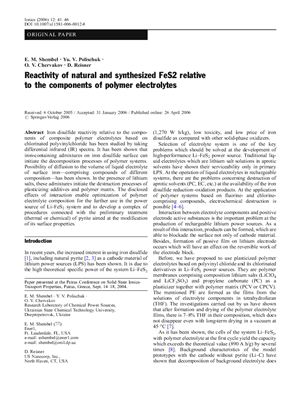Ionics. -2006. - № 12 Р. 41–46.
Paper presented at the Patras Conference on Solid State Ionics-Transport Properties, Patras, Greece, Sept. 14–18, 2004.
Iron disulfide reactivity relative to the components of composite polymer electrolytes based on
chlorinated polyvinylchloride has been studied by taking differential infrared (IR) spectra. It has been shown that iron-containing admixtures on iron disulfide surface can initiate the decomposition processes of polymer systems. Possibility of diffusion to the volume of liquid electrolyte
of surface iron—comprising compounds of different composition—has been shown. In the presence of lithium salts, these admixtures initiate the destruction processes of plasticizing additives and polymer matrix. The disclosed effects of interaction enable optimization of polymer
electrolyte composition for the further use in the power source of Li–FeS2 system and to develop a complex of procedures connected with the preliminary treatment (thermal or chemical) of pyrite aimed at the modification of its surface properties.
В статье описаны механизмы возможного взаимодействия природного и синтезированного дисульфида железа по отношению к компонентам полимерных электролитов на основе хлорированного поливинилхлорида. Дисульфид железа является материалом положительного электрода в литиевом источнике тока. Показана возможность обратимой работы системы Li-FeS2, Приведены результаты рентгенофазованого и дифференциально-термического анализов.
Paper presented at the Patras Conference on Solid State Ionics-Transport Properties, Patras, Greece, Sept. 14–18, 2004.
Iron disulfide reactivity relative to the components of composite polymer electrolytes based on
chlorinated polyvinylchloride has been studied by taking differential infrared (IR) spectra. It has been shown that iron-containing admixtures on iron disulfide surface can initiate the decomposition processes of polymer systems. Possibility of diffusion to the volume of liquid electrolyte
of surface iron—comprising compounds of different composition—has been shown. In the presence of lithium salts, these admixtures initiate the destruction processes of plasticizing additives and polymer matrix. The disclosed effects of interaction enable optimization of polymer
electrolyte composition for the further use in the power source of Li–FeS2 system and to develop a complex of procedures connected with the preliminary treatment (thermal or chemical) of pyrite aimed at the modification of its surface properties.
В статье описаны механизмы возможного взаимодействия природного и синтезированного дисульфида железа по отношению к компонентам полимерных электролитов на основе хлорированного поливинилхлорида. Дисульфид железа является материалом положительного электрода в литиевом источнике тока. Показана возможность обратимой работы системы Li-FeS2, Приведены результаты рентгенофазованого и дифференциально-термического анализов.

